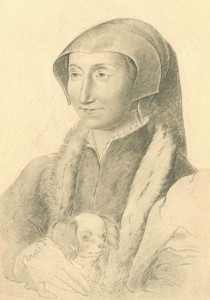
On this day in history, 21st December 1549, Margaret of Navarre (also known as Marguerite de Navarre, Marguerite of Angoulême and Marguerite de France) died aged 57. You can read more about her in the following articles:-
- The Early Life of Anne Boleyn Part Four – The French Influence
- Anne Boleyn’s Faith
- Holbein’s The Ambassadors: A Renaissance Puzzle? – Part One: Context
- Holbein’s The Ambassadors: A Renaissance Puzzle? – Part Two: Symbols
But here are some facts about this famous Renaissance woman:-
- She was born on the 11th April 1492
- Margaret’s parents were Louise of Savoy and Charles, Count of Angoulême
- Her brother was Francis I of France
- Her father had several illegtimate children with his mistresses
- In 1502 her mother tried to arrange a marriage between Margaret and Prince Henry of England, the future Henry VIII – Boy, did she have a narrow escape!
- Her first husband was Charles IV of Alençon, a man described as “a laggard and a dolt”. She married him in 1509 and he died in 1525. The marriage was childless.
- Margaret married her second husband, Henry II of Navarre, in 1526. The couple had two children: a daughter, Jeanne III of Navarre, and a son, Jean, who died in infancy.
- Margaret’s grandson became Henry IV of France.
- Margaret was acitively involved in freeing her brother, Francis I, after he was taken prisoner at the Battle of Pavia in 1525.
- Margaret wrote the controversial work, which was viewed by some as heresy, “Le miroir de l’âme pécheresse” in 1531. Her brother had to save her from being charged with heresy.
- Margaret was an influential woman, who, with the help of her mother, Louise of Savoy, helped her brother rule France.
- Her “salon”, a gathering of like-minded people, was known as “The New Parnassus” and was famous.
- “Le miroir” was translated by Princess Elizabeth (the future Elizabeth I) as a gift for her stepmother, Queen Catherine Parr.
- Some argue that Margaret influenced the young Anne Boleyn during Anne’s time in France.
- Margaret was a famous patron of the Arts, encouraging many famous writers and artists
- Samule Putnam described as as “The First Modern Woman”